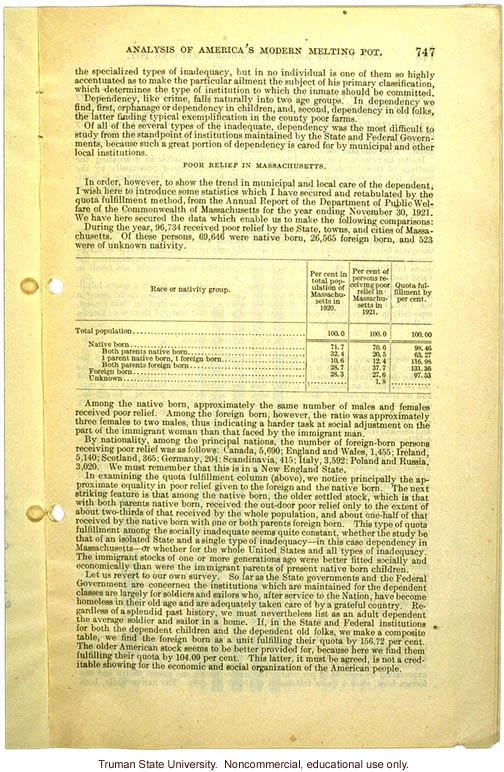Analysis of America's Modern Melting Pot. 747
the specialized types of inadequacy, but in no individual is one of them so highly accentuated as to make the particular ailment the subject of his primary classification, which determines the type of institution to which the inmate should be committed.
Dependency, like crime, falls naturally into two age groups. In dependency we find, first, orphanage of dependency in children, and second, dependency in old folks, the latter finding typical exemplification in the county poor farms.
Of all the several types of the inadequate, dependency was the most difficult to study from the standpoint of institutions maintained by the State and Federal Governments, because such a great portion of dependency is cared for by municipal and other local institutions.
Poor Relief in Massachusetts.
In order, however, to show the trend in municipal and local care of the dependent, I wish here to introduce some statistics which I have secured and retabulated by the quota fulfillment method, from the Annual Report of the Department of Public Wellness of the Commonwealth of Massachusetts for the year ending November 30, 1921. We have here secured the data which enable us to make the following comparisons:
During the year, 96,734 received poor relief by the State, towns, and cities of Massachusetts. Of these persons, 69,646 were native born, 26,565 were foreign born, and 523 were of unknown nativity.
[chart]
Race or nativity group&Per cent in total population of Massachusetts in 1920.&Per cent of persons receiving poor relief in Massachusetts in 1921.&Quota fulfillment by per cent.
Total population...&100.0&100.0&100.00
Native born...&71.7&70.6&98.46
Both parents native born...&32.4&20.5&63.27
1 parent native born, 1 foreign born...&[1]0.6&12.4&116.98
Both parents foreign born...&28.7&37.7&13[7].36
Foreign born...&28.3&27.6&97.53
Unknown...&&1.8&
[end chart]
Among the native born, approximately the same number of males and females received poor relief. Among the foreign born, however, the ratio was approximately three females to two males, thus indicating a harder task at social adjustment on the part of the immigrant woman than faced by the immigrant man.
By nationality, among the principal nations, the number of foreign-born persons receiving poor relief was as follows: Canada, 5,690; England and Wales, 1,455; Ireland, 5,140; Scotland, 365; Germany, 204; Scandinavia, 415; Italy, 3,592; Poland and Russia, 3,020. We must remember that this is a New England State.
In examining the quota fulfillment column (above), we notice principally the approximate equality in poor relief given to the foreign and the native born. The next striking feature is that among the native born, the older settled stock, which is that with both parents native born, received the out-door poor relief only to the extent of about two-thirds of that received by the whole population, and about one-half of that received by the native born with one or both parents foreign born. This type of quota fulfillment among the socially inadequate seems quite constant, whether the study be that of an isolated State and a single type of inadequacy - in this case dependency in Massachusetts - or whether for the whole United States and all types of inadequacy. The immigrant stocks of one or more generations ago were better fitted socially and economically than were the immigrant parents of present native born children.
Let us revert to our own survey. So far as the State governments and the Federal Government are concerned the institutions which are maintained for the dependent classes are largely for soldiers and sailors who, after service to the Nation, have become homeless in their old age and are adequately taken care of by a grateful country. Regardless of a splendid past history, we must nevertheless list as an adult dependent the average soldier and sailor in a home. If, in the State and Federal institutions for both the dependent children and the dependent old folks, we make a composite table, we find the foreign born as a unit fulfilling their quota by 156.72 per cent. The older American stock seems to be better provided for, because we find them fulfilling their quota by 104.09 per cent. This latter, it must be agreed, is not a creditable showing for the economic and social organization of the American people.


